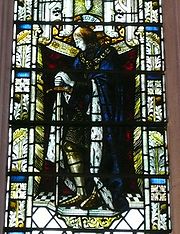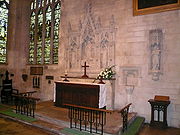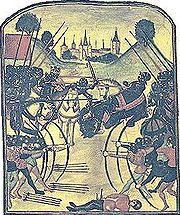
John Wenlock, 1st Baron Wenlock
Encyclopedia


Order of the Garter
The Most Noble Order of the Garter, founded in 1348, is the highest order of chivalry, or knighthood, existing in England. The order is dedicated to the image and arms of St...
(died 1471) was an English soldier, courtier and politician. He fought on the side of both the Yorkists and the Lancastrians in the Wars of the Roses
Wars of the Roses
The Wars of the Roses were a series of dynastic civil wars for the throne of England fought between supporters of two rival branches of the royal House of Plantagenet: the houses of Lancaster and York...
. One historian has gone so far as to call him "Prince of Turncoats."
Early life
He was the son of William Wynell de Wenlock, commonly called William Wenlock, knight of the shire for BedfordshireBedfordshire (UK Parliament constituency)
Bedfordshire was a United Kingdom Parliamentary constituency, which elected two Members of Parliament from 1295 until 1885, when it was divided into two constituencies under the Redistribution of Seats Act 1885.-History:...
in 1404, by his wife Margaret Breton, an heiress of Houghton Conquest
Houghton Conquest
Houghton Conquest is a village and civil parish located in the Central Bedfordshire district of Bedfordshire, England. The parish also includes the hamlet of How End.-History:...
in Bedfordshire.
John Wenlock took part in the invasion of France under Henry V of England
Henry V of England
Henry V was King of England from 1413 until his death at the age of 35 in 1422. He was the second monarch belonging to the House of Lancaster....
, and on 16 August 1421 he received a grant of lands in the bailiwick of Gisors
Gisors
Gisors is a commune in the metropolitan area of Paris, France. It is located northwest from the center of Paris.Gisors, together with the neighbouring communes of Trie-Château and Trie-la-Ville, form an urban area of 12,669 inhabitants...
in Normandy
Normandy
Normandy is a geographical region corresponding to the former Duchy of Normandy. It is in France.The continental territory covers 30,627 km² and forms the preponderant part of Normandy and roughly 5% of the territory of France. It is divided for administrative purposes into two régions:...
, and shortly after, in April 1422, is styled constable of Vernon. In 1433 he was returned to parliament for Bedfordshire, and again in 1436, 1447, 1449, and 1455. He was escheator for Buckinghamshire and Bedfordshire in 1438–9, and he early entered the service of Margaret of Anjou
Margaret of Anjou
Margaret of Anjou was the wife of King Henry VI of England. As such, she was Queen consort of England from 1445 to 1461 and again from 1470 to 1471; and Queen consort of France from 1445 to 1453...
, being first usher of the chamber, and about 1450 chamberlain
Chamberlain (office)
A chamberlain is an officer in charge of managing a household. In many countries there are ceremonial posts associated with the household of the sovereign....
to her. In this capacity he laid the first stone of Queens' College, Cambridge
Queens' College, Cambridge
Queens' College is a constituent college of the University of Cambridge, England.The college was founded in 1448 by Margaret of Anjou , and refounded in 1465 by Elizabeth Woodville...
, on 15 April 1448.
He served also in 1444 as High Sheriff of Bedfordshire and Buckinghamshire
High Sheriff of Bedfordshire and Buckinghamshire
This is a list of High Sheriffs of Bedfordshire and Buckinghamshire. One sheriff was appointed for both counties from 1125 until the end of 1575, after which date separate sheriffs were appointed...
. Wenlock's seat was at Luton
Luton
Luton is a large town and unitary authority of Bedfordshire, England, 30 miles north of London. Luton and its near neighbours, Dunstable and Houghton Regis, form the Luton/Dunstable Urban Area with a population of about 250,000....
, his property there, Someries castle
Someries castle
Someries Castle is a Scheduled Ancient Monument, in the Parish of Hyde, near the town of Luton, Bedfordshire, England. It was built in the 15th century by Sir John Wenlock...
, coming through inheritance. In 1462 he acquired Hertfordshire
Hertfordshire
Hertfordshire is a ceremonial and non-metropolitan county in the East region of England. The county town is Hertford.The county is one of the Home Counties and lies inland, bordered by Greater London , Buckinghamshire , Bedfordshire , Cambridgeshire and...
property forfeited by the former Chief Justice, Sir John Fortescue
John Fortescue
thumb|right|John FortescueSir John Fortescue was an English lawyer, and the author of the De laudibus legum Angliae, an influential treatise on English law.-Early life:...
.
His service to the Crown is also reflected in his employment as a member of some 18 embassies in the 1440s and 1450s. He was knighted in 1449. It appears to have been at one such embassy that he came into contact with the Duke of York
Richard Plantagenet, 3rd Duke of York
Richard Plantagenêt, 3rd Duke of York, 6th Earl of March, 4th Earl of Cambridge, and 7th Earl of Ulster, conventionally called Richard of York was a leading English magnate, great-grandson of King Edward III...
and the Earl of Warwick
Richard Neville, 16th Earl of Warwick
Richard Neville KG, jure uxoris 16th Earl of Warwick and suo jure 6th Earl of Salisbury and 8th and 5th Baron Montacute , known as Warwick the Kingmaker, was an English nobleman, administrator, and military commander...
, and he became a supporter of the latter.
In the Wars of the Roses
During the Wars of the Roses, Wenlock initially fought for the House of Lancaster in the First Battle of St AlbansFirst Battle of St Albans
The First Battle of St Albans, fought on 22 May 1455 at St Albans, 22 miles north of London, traditionally marks the beginning of the Wars of the Roses. Richard, Duke of York and his ally, Richard Neville, Earl of Warwick, defeated the Lancastrians under Edmund, Duke of Somerset, who was killed...
on 22 May, 1455, but his relationship with Warwick led him to subsequently change sides, and it was as a Yorkist that he served as Speaker of the House of Commons
Speaker of the British House of Commons
The Speaker of the House of Commons is the presiding officer of the House of Commons, the United Kingdom's lower chamber of Parliament. The current Speaker is John Bercow, who was elected on 22 June 2009, following the resignation of Michael Martin...
later that year in the parliament of 1455. By the Battle of Blore Heath
Battle of Blore Heath
The Battle of Blore Heath was the first major battle in the English Wars of the Roses. It was fought on 23 September 1459, at Blore Heath in Staffordshire, two miles east of the town of Market Drayton in Shropshire, England.- Background :...
in 1459 Wenlock fought for the House of York. He also fought under the Yorkist banner in the Battle of Mortimer's Cross
Battle of Mortimer's Cross
The Battle of Mortimer's Cross was fought on 2 February 1461 near Wigmore, Herefordshire . It was part of the Wars of the Roses....
, the Second Battle of St Albans
Second Battle of St Albans
The Second Battle of St Albans was a battle of the English Wars of the Roses fought on 17 February, 1461, at St Albans. The army of the Yorkist faction under the Earl of Warwick attempted to bar the road to London north of the town. The rival Lancastrian army used a wide outflanking manoeuvre to...
and the Battle of Towton
Battle of Towton
In 1461, England was in the sixth year of the Wars of the Roses, a series of civil wars between the Houses of York and Lancaster over the English throne. The Lancastrians backed the reigning King of England, Henry VI, an indecisive man who suffered bouts of madness...
, all in what is referred to as the first phase of the War of the Roses.
Having successfully besieged the Tower of London
Tower of London
Her Majesty's Royal Palace and Fortress, more commonly known as the Tower of London, is a historic castle on the north bank of the River Thames in central London, England. It lies within the London Borough of Tower Hamlets, separated from the eastern edge of the City of London by the open space...
for Edward of York, he was part of the latter's triumphal entry into London in 1461 and was elected a knight of the garter
Order of the Garter
The Most Noble Order of the Garter, founded in 1348, is the highest order of chivalry, or knighthood, existing in England. The order is dedicated to the image and arms of St...
a few days after. Later in the year he received appointment as Chief Butler of England
Chief Butler of England
The Chief Butler of England is an office of Grand Sergeanty associated with the feudal Manor of Kenninghall in Norfolk. The office requires service to be provided to the Monarch at the Coronation, in this case the service of Pincera Regis, or Chief Butler at the Coronation banquet.The manor of...
and was made Baron Wenlock. In 1464 he helped Lord Hastings
William Hastings, 1st Baron Hastings
William Hastings, 1st Baron Hastings KG was an English nobleman. A follower of the House of York, he became a close friend and the most important courtier of King Edward IV, whom he served as Lord Chamberlain...
capture Dunstanburgh Castle
Dunstanburgh Castle
Dunstanburgh Castle lies on a spectacular headland on the coast of Northumberland in northern England, between the villages of Craster and Embleton....
.

Edward IV of England
Edward IV was King of England from 4 March 1461 until 3 October 1470, and again from 11 April 1471 until his death. He was the first Yorkist King of England...
, and had command of Calais
Calais
Calais is a town in Northern France in the department of Pas-de-Calais, of which it is a sub-prefecture. Although Calais is by far the largest city in Pas-de-Calais, the department's capital is its third-largest city of Arras....
for him (possibly as deputy of Warwick). When Warwick defected to the Lancastrian camp, Wenlock did not immediately follow him back, however his sympathies clearly remained with his friend, and by 1471 he too had switched sides, accompanying Margaret of Anjou back to England.
Death
At the Battle of TewkesburyBattle of Tewkesbury
The Battle of Tewkesbury, which took place on 4 May 1471, was one of the decisive battles of the Wars of the Roses. The forces loyal to the House of Lancaster were completely defeated by those of the rival House of York under their monarch, King Edward IV...
on 4 May, 1471, he commanded the middle of the Lancastrian line. However, the Lancastrians suffered a crushing defeat, and Wenlock died on the battlefield. He was allegedly killed by his own commander, the Duke of Somerset
Edmund Beaufort, 4th Duke of Somerset
Edmund Beaufort, 4th Duke of Somerset, 6th Earl of Somerset, 3rd Marquess of Dorset, 3rd Earl of Dorset was an English nobleman and military commander during the Wars of the Roses....
, who blamed Wenlock's indecisiveness for the defeat. The Duke of Somerset had led the right flank of the Lancastrian line forward, and expected Wenlock to support him, but Wenlock held back (some suggest deliberately) and the Duke's men were slaughtered. After the Duke's flank retreated he summoned Wenlock and supposedly killed him with a single blow of his mace to the head.
Family
Wenlock died without issue, and his titleBaron Wenlock
Baron Wenlock is a title that has been created three times, once in the Peerage of England and twice in the Peerage of the United Kingdom. The first creation came in 1461 when the soldier Sir John Wenlock was summoned to Parliament as Lord Wenlock...
died with him.
It has been argued that Wenlock did not actually die on the field at Tewkesbury, but together with his second wife, Agnes (widow of Sir John Fray
Sir John Fray
Sir John Fray was a lawyer who served as Lord Chief Baron of the Exchequer and had considerable experience of rivers and watermills....
), perpetuated a hoax by burying another body, and he then lived on for several more years. However, Agnes remarried (for the third time) at some point between September 1473 and October 1474 (to Sir John Say
John Say
Sir John Say, Kt. was an English courtier, MP and Speaker of the House of Commons.-Life:He was the son of John Say, born before 1445, and his wife Maud...
), which casts doubt on the assertion that Wenlock survived six or seven years after Tewkesbury.

